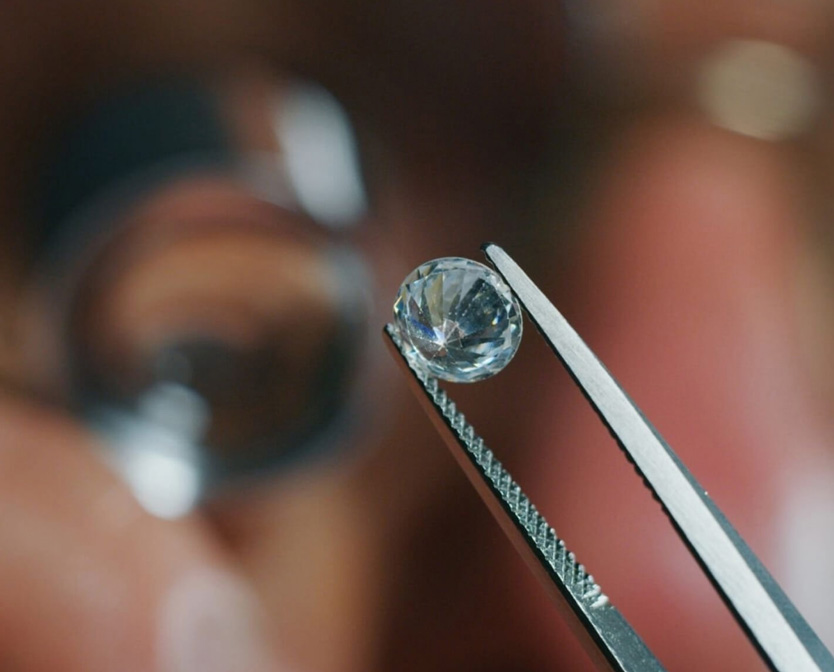Stone Setting Methods
An important step in making jewelry is when craftsmen attach gemstones to a metal mold. Stone setting protects and enhances gemstones by highlighting their shape, size, transparency, and color. You achieve this by keeping the gemstone secure and showcasing its natural beauty.
Jewelry makers use different ways to put a gemstone in jewelry, depending on its size and cut diamonds. The worldwide community accepts and appreciates some of these methods and stone setting techniques, as described below. Each method has its own advantages and is chosen based on the type of stone, design, and desired aesthetic.
Prong Setting
The prong setting is popular for diamonds in jewelry. It has 4 or 6 claws that hold the diamond.
These claws also allow light to enter from all directions. This gives the diamond a larger and more radiant appearance. Plus, it can securely hold bigger diamonds.
Bezel Setting
The rim in a Bezel setting encases and holds the gem. The bezels may have straight, scalloped edges, or you can shape them in any way to fit the stone. You can open or close the backs, and you use them to set earrings, necklaces, bracelets, and rings. Diamonds with warmer hues appear magnificent when encased in yellow gold using a bezel setting.
Channel Setting
Setting stones side by side typically refers to a channel setting or a closely spaced arrangement of stones. People predominantly use this type of setting for wedding and anniversary rings.
In a Channel setting, we place the gemstones adjacently without any metal division. Subsequently, the craftsmen mold the outer metal rim over the stone edges. This provides more protection for the diamond's edge than a bead or prong setting, resulting in a smooth outer surface.
Bar Setting
People often use this setting in anniversary and wedding bands, as well as tennis bracelets and necklaces. This is a ring with diamonds, each held in place by a slender bar shared between two gems. The Bar setting merges a modern and traditional aesthetic.
Pave Setting
Little beads of metal separate stones set closely together. Accent stones set in pave can amplify the beauty of a simple central stone. Conventionally, pave is a term used to describe a broad area filled with beaded metal and gemstones.
Using many small stones creates the pave setting. Tiny prongs set these loose diamonds.
The purpose is to create a continuous surface of radiance and shimmer. This allows light to reflect off the diamond's facets. Engagement rings and earrings prefer this setting type.
Tension Setting
A tension setting is a diamond ring setting that uses pressure to hold the diamond in place. It doesn't employ tines, a groove, or a rim setting. The gold or platinum setting has a spring that pushes the diamond. It also has small etchings/grooves to hold the diamond securely.
The diamond appears to 'hover' or hang in the air without any visible support. This is a secure style for setting a diamond in an engagement or wedding ring.
Gypsy or Flush Setting
The Flush setting might be familiar to you from men's jewelry pieces you've come across. The band places the gem in itself and holds it with its metal. Just the peak of the jewel can be seen.
Bead Setting
Bead setting involves positioning gems into pre-drilled cavities on a piece of jewelry. To do this, use a bur to create a spot on the metal surface where you can place the gem.
After placing the stone, I use an engraving tool to lift metal beads from the surface and secure it in position. The beading tool rounds and pushes these prongs over the edge of the stone. While this technique isn't widely utilized in the present day, it was extremely prevalent in the 20th century.
Invisible Setting
Placing stones close together is a difficult technique used to hide any metal in between, creating an unseen setting. This makes the surface look smooth and seamless. Specialists consider it to be an advanced and enhanced method of setting stones. In this setup, we carve stones with grooves and then place them on metal tracks to keep them secure.
Cluster Setting
Creating a cluster setting style involves placing diamonds or gemstones closely together in a group. Sometimes, people arrange these stones to mimic a stylized flower or simply in an abstract pattern. Cluster rings often feature multiple layers, rising significantly above the hand. The stones can be arranged to look open and airy, or they can be arranged more compactly.







